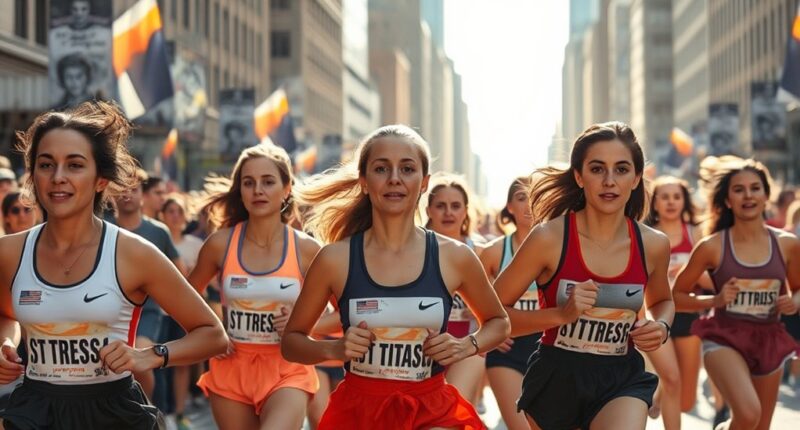The first women’s marathon in 1967 challenged outdated gender stereotypes and proved women could compete in long-distance running. This bold act inspired a global movement for gender equality in sports, leading to policy changes, increased opportunities, and a shift in public perception. It sparked ongoing efforts to eliminate barriers and promote inclusivity. If you’re curious about how this event forever transformed sports, there’s much more to explore about its lasting legacy.
Key Takeaways
- It challenged societal gender norms, proving women could compete in long-distance running.
- The race inspired increased female participation and visibility in sports worldwide.
- It prompted policy reforms promoting gender equality in sports organizations and competitions.
- The event demonstrated women’s athletic capabilities, breaking stereotypes and record barriers.
- Its legacy fostered ongoing efforts toward inclusivity, fairness, and equal opportunities for women athletes.
The Historical Context Before the Race
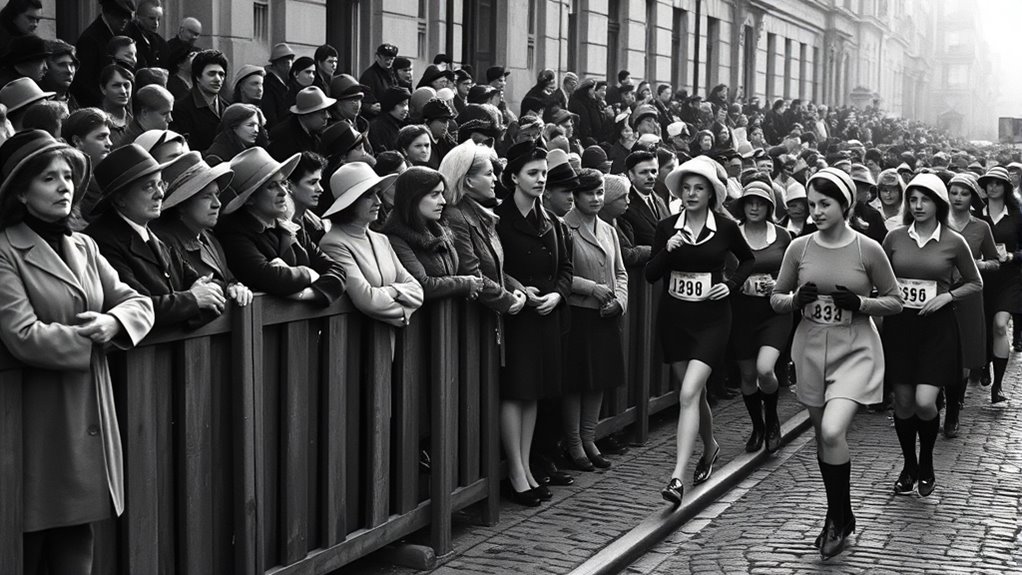
Before the first women’s marathon took place, societal attitudes toward women’s athletic participation were largely dismissive or outright hostile. Gender norms dictated that women weren’t suited for intense physical activity, and athletic opportunities for women were scarce. Many believed running long distances was unladylike or harmful to health. These outdated beliefs limited women’s access to sports, reinforcing stereotypes that kept them on the sidelines. Women who wanted to compete faced significant barriers, from lack of proper training facilities to social discouragement. The prevailing mindset didn’t just restrict participation; it often dismissed women’s athletic ambitions altogether. This hostile environment made the idea of a women’s marathon seem almost impossible, setting the stage for a groundbreaking change in sports history. Additionally, the lack of proper training resources and support further hindered women’s ability to pursue long-distance running at competitive levels. The absence of women’s athletic organizations also meant there was minimal institutional backing to challenge these societal norms.
The Athletes Who Paved the Way
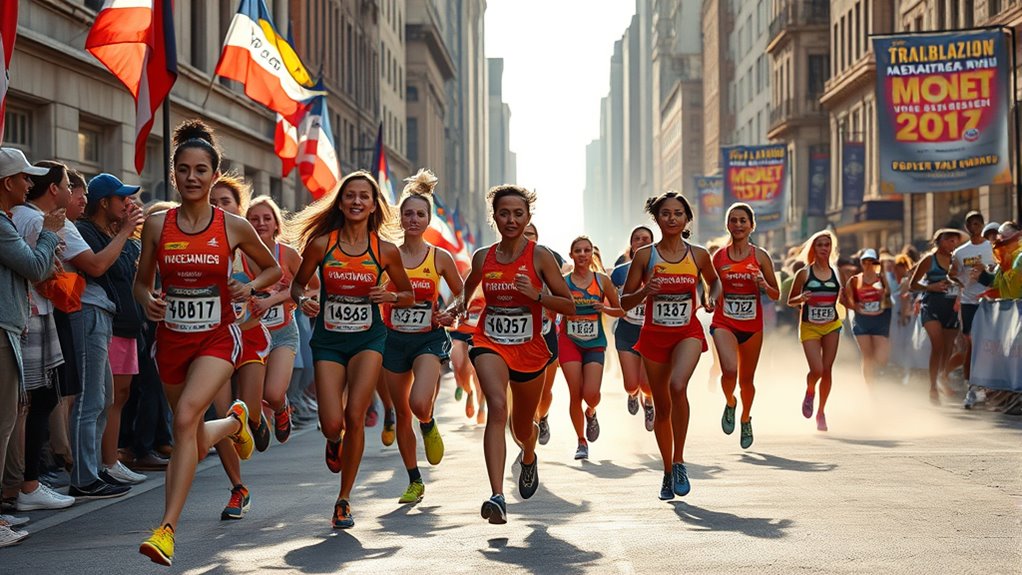
Many pioneering women broke through societal barriers to demonstrate that athletic achievement was possible regardless of gender. These athletes achieved remarkable athletic breakthroughs that challenged stereotypes and expanded what women could accomplish. Their pioneering spirit fueled their determination to compete at the highest levels, even when societal expectations tried to hold them back. You can’t overlook figures like Kathrine Switzer, who defied official bans to enter marathons, or Roberta Gibb, the first woman to run the Boston Marathon unofficially. Their courage and perseverance laid the groundwork for future generations, proving that gender didn’t determine athletic potential. These trailblazers showed that passion and resilience could reshape sports history, inspiring women worldwide to chase their athletic dreams without boundaries. Recognizing their contributions helps us understand the importance of Glycolic Acid Benefits for Skin in celebrating progress and breaking barriers.
Overcoming Societal Barriers and Stereotypes
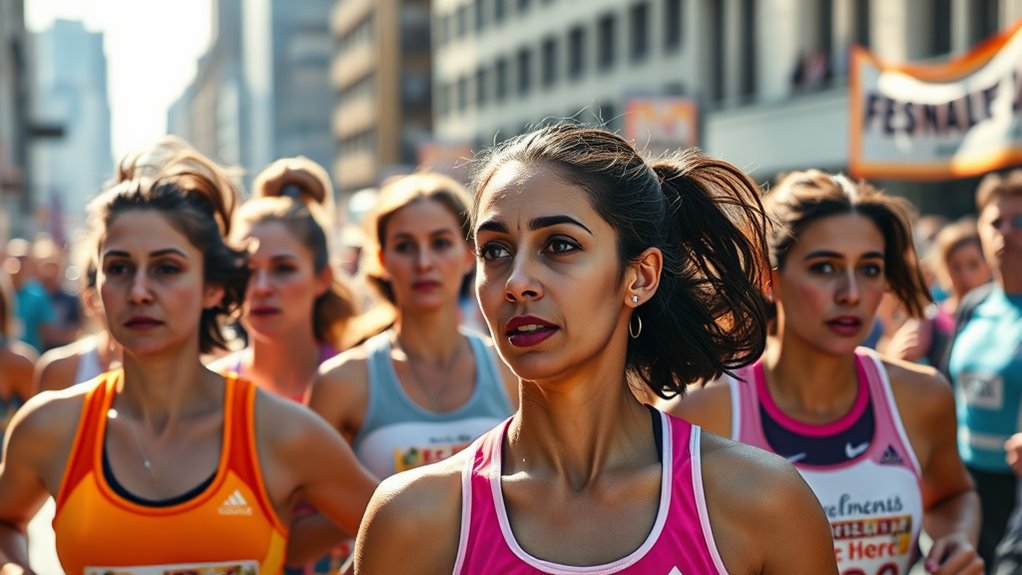
Overcoming societal barriers and stereotypes has been a critical challenge for women in sports, often requiring extraordinary courage and resilience. Society’s expectations dictated that women shouldn’t participate in intense physical activities or push beyond traditional roles. Gender stereotypes fueled doubts about women’s strength, endurance, and dedication, making it harder to gain acceptance. You had to confront these biases daily, proving that your passion for running and competition was valid. Many women faced ridicule, discouragement, or outright bans, but they persisted. By breaking through these societal expectations, they challenged outdated beliefs about gender and athleticism. Your determination helped shift perceptions, paving the way for future generations to pursue their athletic dreams without fear of judgment or discrimination. The importance of societal norms in shaping perceptions and acceptance in various domains also underscores how deeply ingrained attitudes can influence progress. Recognizing the importance of cookie categories in online spaces also underscores how societal norms can influence perceptions and acceptance in various domains. Additionally, understanding how feminist movements have played a role in challenging these stereotypes highlights the ongoing efforts to promote gender equality in sports and beyond.
The Race Day: A Pivotal Moment
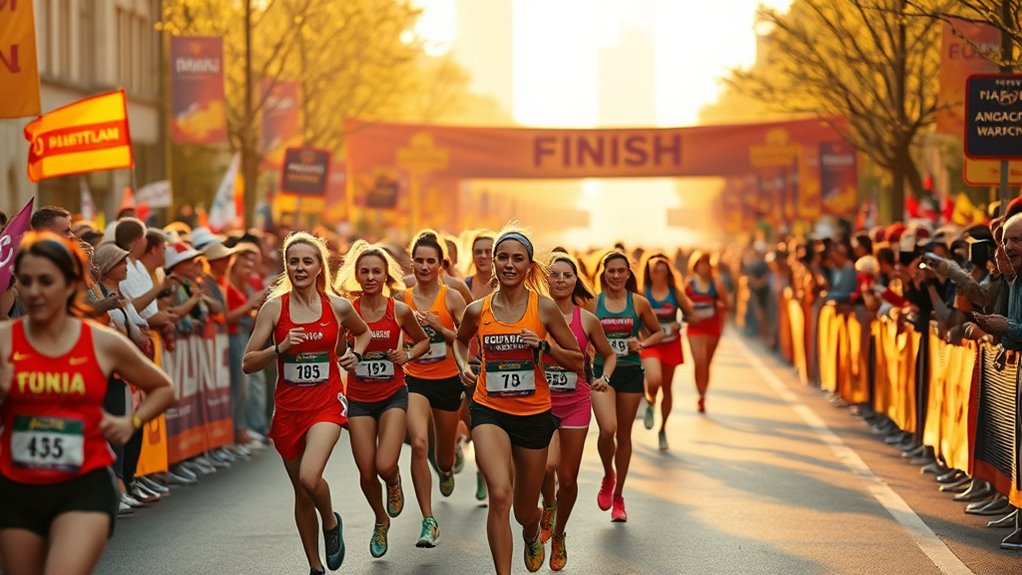
Race day stands as a defining moment where determination and preparation come together, testing your limits and challenging societal expectations. As you step onto the course, you’ll feel the electric energy of spectator enthusiasm fueling your run. Managing race day logistics—like arrival times, hydration stations, and pacing—becomes essential to your success. To stay focused, consider these tips:
Race day tests your limits and fuels your determination with enthusiastic supporters and strategic planning.
- Arrive early to beat the rush and soak in the atmosphere.
- Engage with spectators who cheer loudly, boosting your motivation.
- Monitor race logistics closely, ensuring you’re in the right place at the right time.
- Password strength indicator helps runners stay secure when accessing their race apps or digital bibs, ensuring their personal information remains protected.
- Remember that sustainable event practices can minimize environmental impact, making your race day more eco-friendly. Incorporating eco-friendly glamping options for race organizers and participants can enhance the overall sustainability of large sporting events, reducing waste and promoting eco-conscious travel to and from the venue. Additionally, understanding Relationships – Personality Test concepts can foster better connections among team members and volunteers involved in event organization.
This day isn’t just about crossing the finish line; it’s about embodying the courage to challenge norms amid a sea of enthusiastic supporters and carefully orchestrated race elements.
Immediate Reactions and Media Coverage
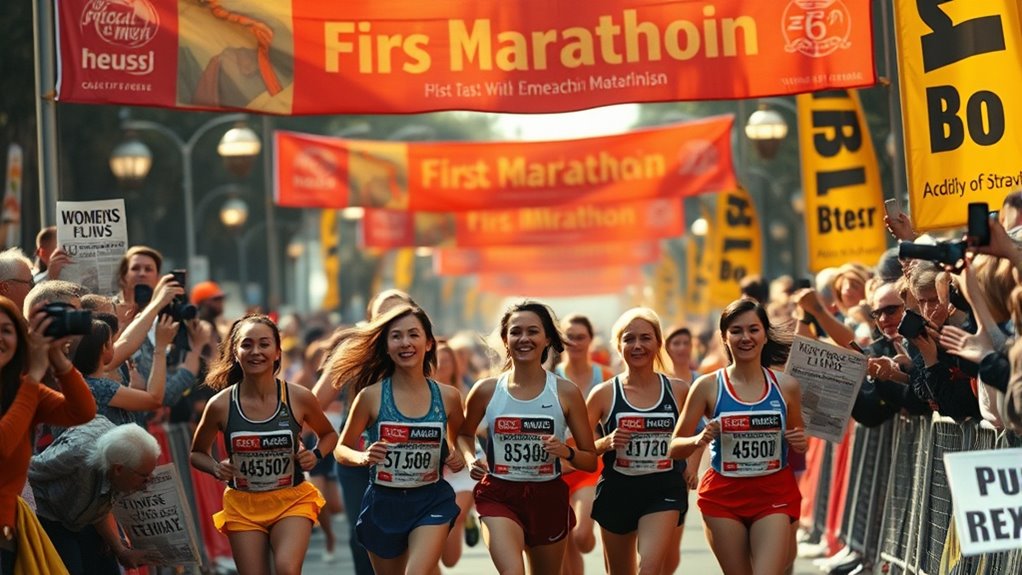
The immediate reactions and media coverage following the first women’s marathon exploded onto the public stage, capturing worldwide attention. News outlets bombarded audiences with stories about the women runners, fueling a media frenzy that highlighted their bravery and determination. Public reactions ranged from admiration to controversy, as many celebrated the historic achievement, while others questioned its legitimacy. You’d notice headlines emphasizing the groundbreaking nature of the event, sparking conversations about gender equality in sports. Social media, although in its early stages, buzzed with support and debate. This intense media focus amplified the marathon’s significance, making it impossible to ignore. The coverage not only honored the runners but also ignited broader discussions about women’s rights and societal norms.
Long-Term Impacts on Women’s Athletics
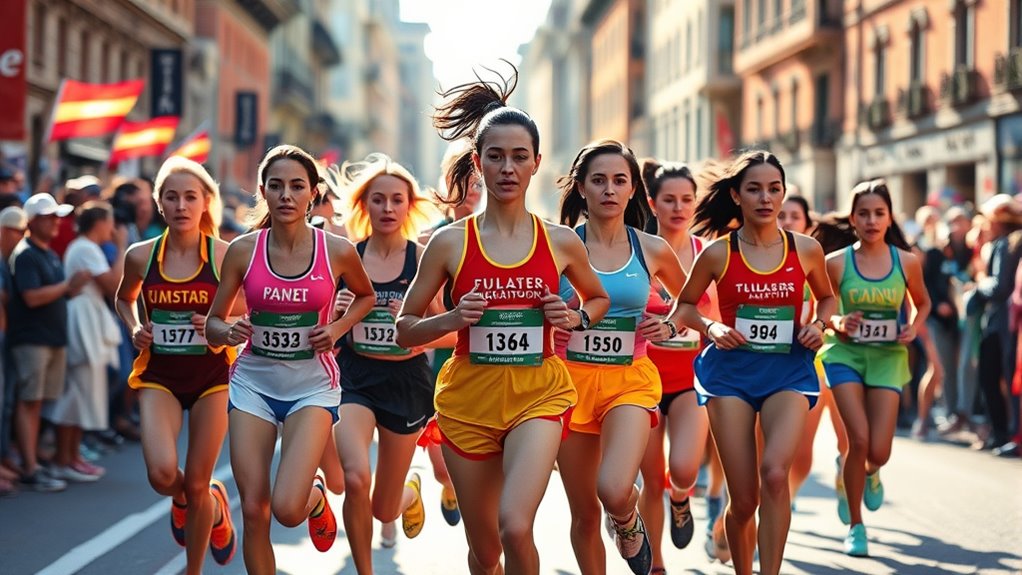
The first women’s marathon marked a pivotal milestone that considerably advanced women’s participation and recognition in athletics. Its long-term impacts are clear in how they fostered gender equality and inspired more women to join sports. Here are three key effects:
- Increased Sports Participation: More women now compete at all levels, breaking barriers that once limited their involvement.
- Enhanced Visibility: Media coverage and public interest grew, highlighting women’s athletic achievements and challenging stereotypes.
- Policy Changes: The race prompted organizations to reevaluate and promote gender equality, supporting women’s access to training and resources.
Your participation helped shift perceptions, paving the way for a more inclusive sports landscape. The marathon’s legacy continues to empower women to pursue athletics without limits.
Changes in Policy and Sports Governance
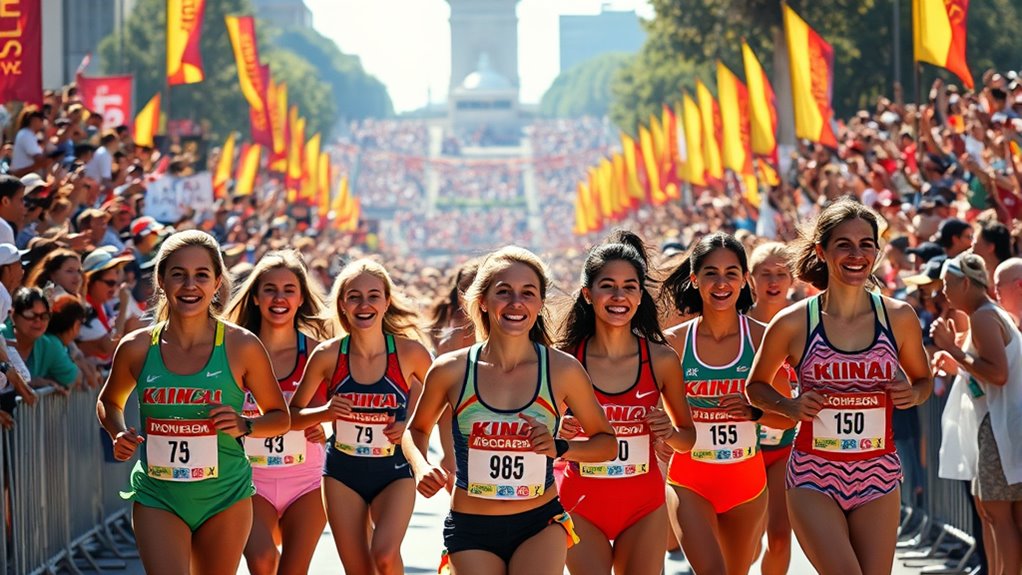
The visibility and momentum created by the first women’s marathon prompted sports organizations and governing bodies to reexamine their policies on gender equality. As a result, many implemented policy reforms aimed at promoting gender equity in sports. These reforms included establishing clear guidelines for fair competition, ensuring equal prize money, and opening leadership roles for women in sports governance. You’ll notice that governing bodies became more attentive to gender disparities, actively working to eliminate barriers that prevented women from competing and leading. These changes helped shift sports culture toward inclusivity and fairness, setting a precedent for future equality initiatives. Overall, the marathon’s impact pushed organizations to prioritize gender equity, fostering a more balanced and representative sports environment.
Legacy and Continuing Progress in Female Sports
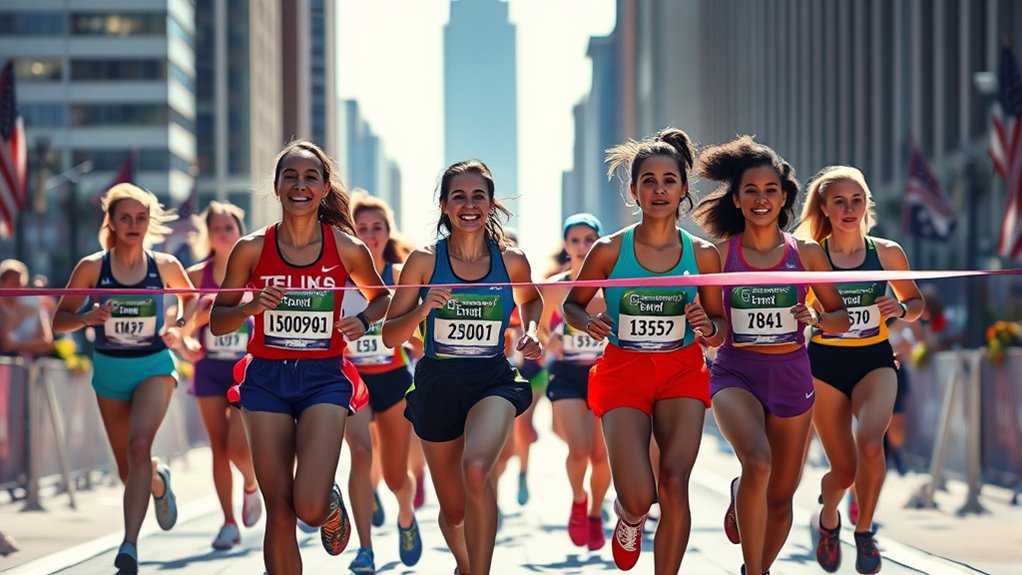
How has the legacy of the first women’s marathon continued to shape female sports today? Your participation in sports has grown, driven by greater gender equality inspired by that historic race. Today, women compete at every level, breaking records and challenging stereotypes. Here are three ways progress continues:
- Increased sports participation among women worldwide, promoting confidence and health.
- Policy changes ensuring gender equality, like equal prize money and access to facilities.
- Role models and pioneers inspiring future generations to pursue athletic goals without limitations.
The first women’s marathon didn’t just make headlines; it ignited a movement that keeps pushing for fairness and inclusion. Your support and ongoing efforts are essential in shaping a future where women’s sports thrive equally.
Frequently Asked Questions
How Did the First Women’S Marathon Influence Young Girls’ Participation in Sports?
You see, the first women’s marathon inspired young girls by showcasing gender equality and athletic empowerment. It proved that women could compete in endurance sports, breaking stereotypes and encouraging participation. Your generation now has more role models and opportunities, thanks to that historic race. It’s a reminder that perseverance and determination can challenge societal norms, inspiring countless girls to pursue sports and believe in their athletic potential.
Were There Any Notable Secret Preparations for the First Women’S Marathon?
Think of secret training as hidden roots fueling a tree’s growth. For the first women’s marathon, some runners used covert strategies, training in disguise or outside public eye to prepare for race day. These secret preparations helped them build strength and endurance without drawing attention or facing opposition. Their clandestine efforts, like silent warriors, laid the groundwork for future women’s sports, proving determination can thrive in secrecy.
What Were the Long-Term Health Effects on the Pioneering Female Runners?
You might wonder about the long-term health effects on these pioneering female runners. While they faced gender disparities in sports, their dedication pushed athletic performance forward. Many experienced physical challenges, but their courage helped improve safety and training standards for women. Their perseverance not only advanced women’s participation in athletics but also highlighted the importance of health awareness, inspiring future generations to pursue sports without fear of long-term harm.
How Did the Race Impact Women’S Sports Funding and Sponsorship Opportunities?
Imagine the dawn of a new era, much like the Renaissance, where your efforts in the first women’s marathon sparked a shift. Your trailblazing race challenged gender equality, prompting increased sponsorship growth for women’s sports. This momentum encouraged more funding and opportunities, empowering future generations. Today, your courage continues to inspire change, ensuring women’s sports receive the recognition and resources they deserve, shaping a more equitable athletic landscape.
Did the Race Inspire Similar Events in Other Countries Immediately Afterward?
You see, the race definitely sparked international influence and inspired similar events worldwide. Global reactions were overwhelmingly positive, encouraging women everywhere to participate in long-distance running. Many countries quickly organized their own women’s marathons, motivated by the groundbreaking achievement. This ripple effect showed how one bold step could ignite a global movement, proving that women’s sports could break barriers across borders and inspire millions to chase their dreams.
Conclusion
The first women’s marathon was like a spark igniting a wildfire of change in sports. It challenged stereotypes, broke barriers, and inspired countless women to chase their dreams. As you look back, remember how this race reshaped athletic history, proving that perseverance and courage can rewrite societal norms. Just as a single drop creates ripples, this race’s impact continues to inspire progress, reminding you that women’s sports are unstoppable in their pursuit of equality and excellence.
